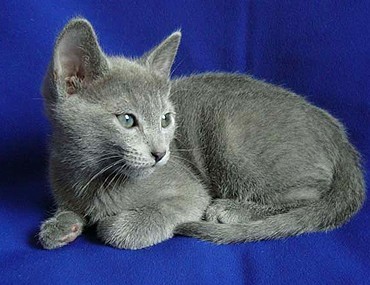Background
The origin of the Russian Blue cat breed is a bit of a mystery, but most experts believe that they originated in the port of Arkhangelsk, Russia – also known as the beautifully-named Archangel Isles. In fact, because “Arkhangelsk” means “archangel” in Russian, these distinctive looking cats are also known as Archangel Blues.
The breed made the trip from Russia to Great Britain sometime in the mid-1800s, likely brought by sailors. Though the Russian Blue first appeared at the Crystal Palace in England in 1875, its development was limited to Scandinavia and Russia until after the Second World War. During this time, it was interbred with Siamese cats. After the war, the breed made its way over to the United States. Today, most of the Siamese has been bred out, and the Russian Blue is one of the most popular cats in America.  Cat facts
Cat facts
The Russian Blue is a naturally occurring breed, meaning it is not the end result of breeders mixing cat breeds together. In addition, the Russian Blue has quite a legacy! Here are some interesting facts:
- Some believe that the Russian Blue was a royal favorite among Russian Czars and, later, English Monarchs.
- Russian folklore considers the Russian Blue both a healing charm and a good luck charm.
- Tom from the “Tom and Jerry” cartoon is often considered to be a Russian Blue because of his blue-gray coating.
- The Russian Blue only comes in one color – a blue-gray.
- The lifespan of the Russian Blue ranges from 15-20 years.
- The Russian Blue is a medium sized cat, weighing between 10 and 15 pounds.
What are they like?
The Russian Blue is one of the most beautiful cat breeds around: the stunning, plush double-coat of blue tipped with silver, the shining emerald eyes, and the large elegant ears are easy to fall in love with.
Russian blues can be shy, especially around strangers, but don’t mistake their reserved personality for a boring one! They can be very sweet, affectionate cats once they warm up to you. Russian Blues can be very playful and, like most cats, love to jump, climb, and survey the world below. Russian Blues also love to play with feather toys, and are even happy playing fetch. They are also very smart and easy to train.
The Russian Blue is a very healthy, hardy cat with no specific health problems.
Right for you?
Here are some things to think about if you’re considering welcoming a Russian Blue into your family:
- Word on the street is, the Russian Blue is better tolerated by those who have allergies. Part of the logic is that the cat’s thick coat traps allergens close to the coat, while another possibility is the fact that the Russian blue produces less of a common glycoprotein that causes cat allergies.
- Grooming is easy. The thick coat requires a brushing or combing once or twice a week, but the Russian blue sheds very little.
- They can be very shy around strangers. Don’t expect a Russian Blue to give a warm welcome to strangers. Often startled easily, the Russian Blue will hide when unfamiliar people approach.
- Not a fan of change. From feeding time to hygiene, the Russian Blue likes things to be predictable and can become nit-picky.
If you have any questions or concerns, you should always visit or call your veterinarian – they are your best resource to ensure the health and well-being of your pets.
